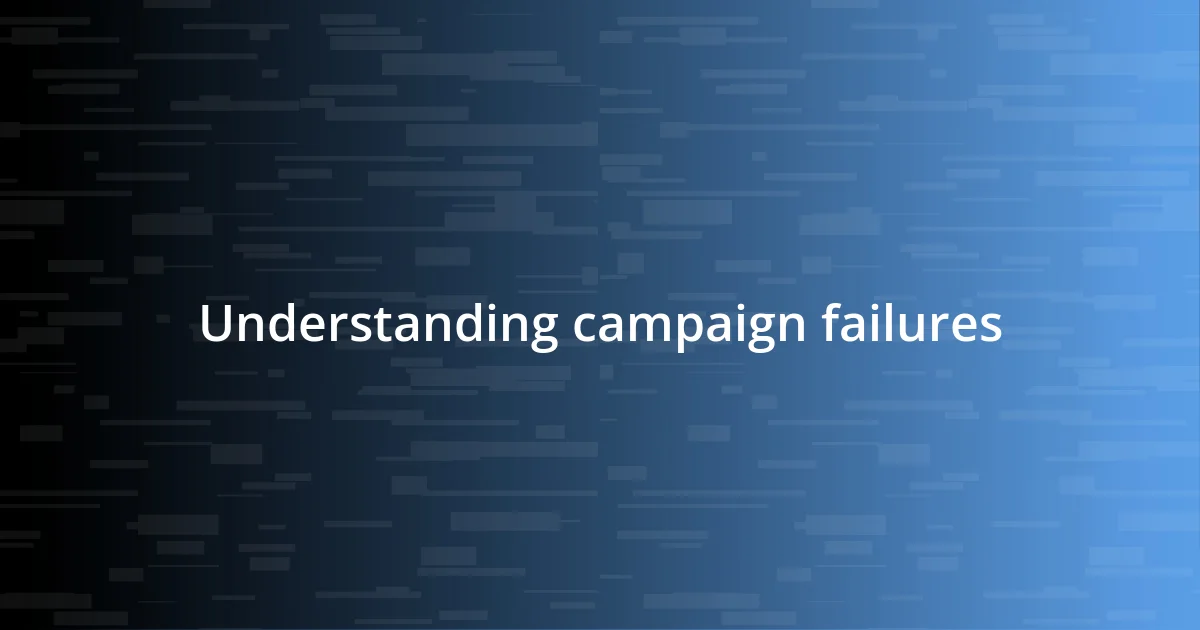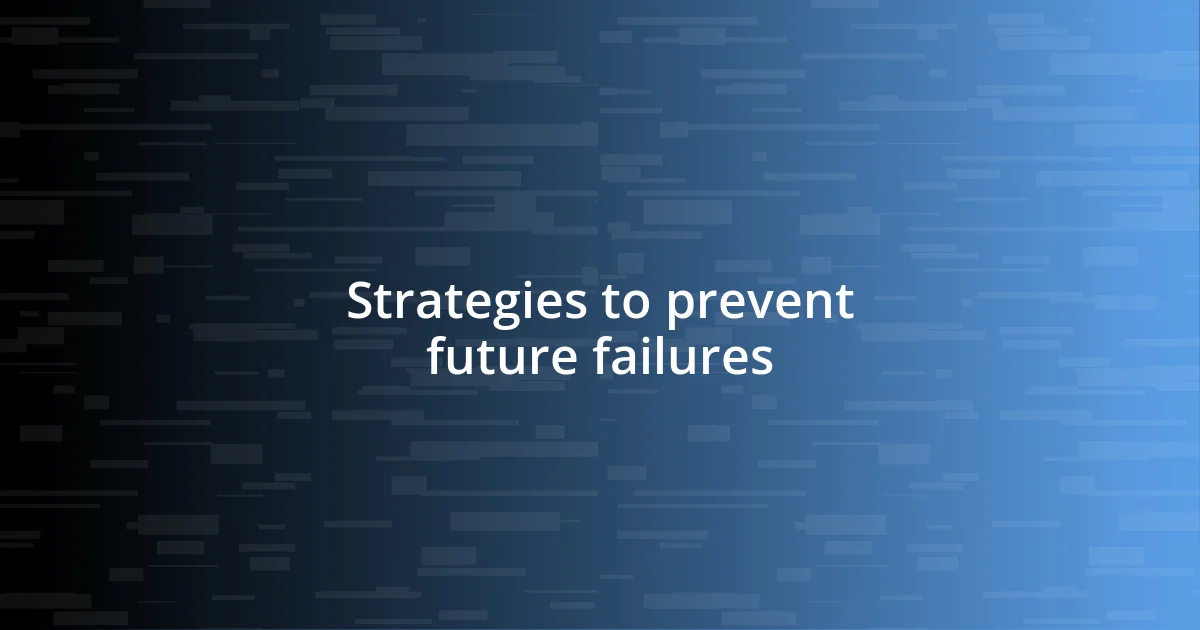Key takeaways:
- Understanding the audience and emotional connection is crucial for campaign success, emphasizing the importance of empathy and adaptability.
- Clear objectives and audience insights prevent campaign failures, while testing and iterating can improve outcomes significantly.
- Success is measured not just by metrics but by the emotional impact and community connection fostered during campaigns.

Understanding campaign failures
Understanding campaign failures often feels like peeling back layers of an onion—each layer reveals new insights and emotions. One of my own campaign experiences ended in disappointment when we misjudged our target audience. Looking back, I recall that sinking feeling when the results rolled in; it was a harsh reminder that knowing who you’re speaking to can make or break your efforts.
I often ask myself, why did we miss the mark? It’s crucial to consider not just the strategy but also the emotional connection our message failed to make. I remember a campaign where we relied heavily on data, neglecting the human element; that mistake led to a disconnect that was palpable. When our audience couldn’t resonate with what we were promoting, it highlighted the importance of empathy in building effective campaigns.
It’s easy to brush off campaign failures as mere statistics on a spreadsheet, but each setback carries its lessons. I learned that flexibility is paramount. In one instance, our initial concept looked great on paper, but we had to pivot mid-way when feedback indicated it wasn’t resonating. The realization hit me hard: listening to the audience matters more than sticking to a rigid plan. Have you ever felt that urge to hold onto your ideas, even when they’re faltering? I know I have, and it’s a humbling experience to let go and adapt.

Common reasons for campaign failure
One common reason campaigns fail is a lack of clear objectives. I remember a time when we launched a social media campaign without well-defined goals. We aimed to increase engagement, but without knowing what that truly meant—likes, shares, comments—we ended up feeling lost in a sea of data. The metrics we chased didn’t translate into meaningful connections, leaving us frustrated at the end of it all.
Another frequent pitfall is underestimating the competition. I can recall a campaign we ran during a peak season without thoroughly analyzing our rivals. Instead of standing out, we blended in, and the audience didn’t see anything unique in our message. Here are some common reasons for campaign failure that resonate with what I’ve experienced:
- Unclear Objectives: Without specific, measurable goals, it’s easy to lose sight of what really matters.
- Audience Mismatch: Don’t forget to deeply understand who your audience is; otherwise, your message falls flat.
- Neglected Competition: Ignoring what others are doing can lead to missed opportunities for differentiation.
- Content Quality: Poor quality content dilutes your message; invest in creating something that resonates.
- Insufficient Testing: Failing to test different elements before launch can lead to avoidable mistakes and disappointment.
Every one of these points serves as a reminder to approach campaigns with both strategy and heart.

Key takeaways from failed campaigns
When reflecting on the key takeaways from failed campaigns, one lesson that stands out to me is the significance of adaptability. I recall a project where we were determined to stick to our original concept, even when the feedback was lukewarm. It felt frustrating to change gears, but ultimately, the moment we embraced flexibility, the campaign started to gain traction. This taught me that sometimes, letting go of what we thought was right can lead to unexpected breakthroughs.
Another crucial point I’ve learned is the need for a feedback loop. In one instance, we launched a series of ads without gathering input from our audience beforehand. The result? A few cringeworthy miscommunications that left me wishing we had asked for opinions first. Engaging with our audience not only invites insight, but it also fosters a sense of community. It’s remarkable how simply checking in can shift a campaign’s trajectory.
Lastly, I can’t stress enough the importance of passion in your messaging. There was a campaign I worked on where the team was so focused on metrics and performance data that we lost sight of the core message. I vividly remember presenting our results and feeling the emptiness of those figures—we had neglected to energize our narrative. People can tell when a brand genuinely believes in what it offers. Authenticity resonates much more than polished stats, and that’s a truth I carry with me in every project.
| Key Takeaways | Experiential Insight |
|---|---|
| Adaptability | Embracing changes in direction can lead to unexpected success. |
| Feedback Loop | Engaging audience input can shift campaign outcomes significantly. |
| Passion | Authentic messaging resonates deeper than performance metrics. |

Strategies to prevent future failures
One effective strategy to prevent future failures is to establish a clear set of objectives before launching any campaign. In my own experience, I once worked on a project where we took the time to outline specific, measurable goals. We wanted not just to boost our engagement rates but also to define what that would look like week-to-week. This strategic clarity not only guided our decisions but also kept the team aligned and focused, ensuring our energy was directed toward achieving tangible results.
Deep audience understanding is another cornerstone for successful campaigns. I recall a situation where we conducted user surveys before rolling out a new product campaign. The insights we gathered were eye-opening! It was fascinating to discover that our target demographic had preferences we hadn’t anticipated. By tailoring our content to speak directly to their needs and preferences, we crafted a message that resonated much better, driving engagement and conversion. Isn’t it remarkable how knowing your audience can turn a lackluster campaign into a home run?
Finally, testing and iterating is crucial. I’ve learned this firsthand after launching a campaign that didn’t quite land. In hindsight, we should have run smaller tests on campaign elements beforehand. Now, I always advocate for A/B testing to refine messaging and visuals before a full rollout. Going through that process not only saved us from embarrassment but also led to significant improvements. It’s worth asking yourself: How can you iterate to ensure your campaign resonates before it reaches the bigger audience? By embracing this proactive approach, you’re not just reacting to failures—you’re actively preventing them.

Learning from competitor mistakes
I’ve found immense value in monitoring what competitors have learned from their own missteps. For instance, I once observed a brand launching a social media campaign that completely missed the mark with its audience. It wasn’t just the content; it was how they failed to address current events that were top of mind for their followers. This taught me to always stay alert to the larger cultural landscape and consider how external factors might influence our messaging. What lessons are hiding in plain sight from others’ blunders?
A memorable experience I had was when I analyzed a failed product launch by a competitor. They invested heavily in influencer partnerships but didn’t resonate with their target demographic. Every time I revisited their case, I recognized the importance of genuine alignment between brand values and chosen influencers. It’s not enough to just throw money at influencers; they need to genuinely connect with your mission. It begs the question: Are you really ensuring that your partnerships reflect who you are as a brand?
I recall a different competitor who had a beautifully crafted campaign but neglected to include any form of engagement. It was a stunning display that quickly fizzled out. This drove home for me that simply having a visually appealing campaign isn’t sufficient. It needs to invite dialogue and connection with the audience. Have you ever stepped back and wondered if your campaigns are authentically welcoming conversations? From these missteps, I’m reminded to create not just an experience but also an opportunity for interaction.

Measuring success beyond metrics
Success in campaigns isn’t solely about numbers—it often lies in the stories behind them. For example, I once wrapped up a campaign that seemed underwhelming on paper, yet the heartfelt responses from our community filled my inbox with gratitude. People shared how the message resonated with their personal struggles, which I hadn’t anticipated at all. I learned then that connections can offer a depth of success that metrics sometimes fail to capture. Are we truly listening to the voices of our audience, or are we too focused on chasing figures?
Embracing qualitative data is another dimension I’ve come to value immensely. After a campaign that didn’t yield the expected results, I took the time to interview a few participants. Their candid feedback illuminated misunderstandings and highlighted emotional barriers we hadn’t considered. It was an eye-opener; suddenly, success wasn’t just about focusing on conversions but also on fostering a sense of belonging and trust. How often are we missing these vital insights by not asking the right questions?
Lastly, reflecting on the emotional impact of our campaigns has transformed how I measure success. I remember running a fundraising campaign where, beyond the funds raised, I saw an outpouring of community support and shared stories. The warmth and unity created during that time were palpable and far outweighed any metric I looked at. This made me realize that fostering a community is a profound measure of success—one that can reflect a campaign’s true impact beyond traditional analytics. How often do we celebrate these intangible victories in our work?

Building resilience in marketing teams
Building resilience in marketing teams requires cultivating a culture where failure isn’t just seen as a setback but as an opportunity for growth. I recall a campaign where we missed our target by a wide margin. Instead of pointing fingers, we gathered as a team to dissect what went wrong. This honesty and vulnerability allowed us to come away with actionable insights, strengthening our bond and empowering us to take risks in the future. Have you ever considered how turning a failure into a learning session could transform your team’s mindset?
Moreover, celebrating small wins can drastically uplift team morale, especially after a setback. I remember a time when our team faced a rough patch with a product launch. Amid the challenges, we made it a point to acknowledge each small success, like positive customer feedback or just getting a campaign live on time. These moments of recognition not only fostered resilience but also built a shared sense of purpose that kept us motivated. What celebrations can you implement to fortify your team’s spirit during tough times?
Finally, fostering open communication channels is essential for resilience. In my experience, after a campaign flopped, we instituted regular check-ins where team members could voice their thoughts, fears, and suggestions without judgment. This created an environment of trust, making it easier to adapt and pivot from setbacks. It’s fascinating how simply inviting dialogue can unveil incredible ideas and solutions. Are you providing a safe space for your team to share their insights and strategies, especially after a challenging project?














